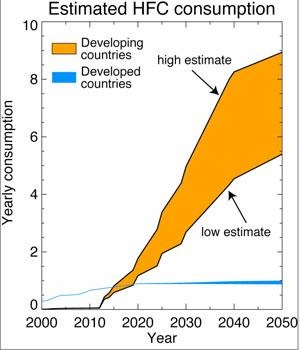
Hydrofluorocarbons, or HFC’s are replacing more environment/ozone damaging chemicals but are becoming a real threat themselves. Large amounts of carbon dioxide are emitted by HFC’s increasingly employed as replacements in air conditioners, refrigerators, fire-fighting equipment and insulation foams. This could impact our ability to keep global temperature rise under two degrees Celsius this century. According to United Nations Environment Programme (UNEP) study - by 2050 HFCs could be “responsible for emissions equivalent to 3.5 to 8.8 gigatonnes (Gt) of carbon dioxide, comparable to total current annual emissions from transport, estimated at around six to seven Gt annually.” How effective are current climate change efforts is a complementary consideration.
(Above Graph Courtesy of Science Daily)
Saving the Ozone – a Successful Global Program?
According to Achim Steiner, UNEP Executive Director: “The more than 20 year-old international effort to save the ozone layer ranks among the most successful examples of cooperation and collaboration among nations – the original chemicals, known as CFCs [chlorofluorocarbons], were phased out globally in 2010 and countries are freezing [the use of] and then phasing out the replacements, HCFCs. However a new challenge is rapidly emerging as countries move ahead on HCFCs and that is HFCs. While these ‘replacements for the replacement’ chemicals cause near zero damage to the ozone layer, they are powerful greenhouse gases in their own right. The good news is that alternatives exist alongside technological solutions, according to this international study. While assessing the absolute benefits from switching needs further scientific refinement, there is enough compelling evidence to begin moving away from the most powerful HFCs today,” he added. (Read: ”Private Investment is Key to Climate Change” -
diplomaticallyincorrect.org/films/blog_post/private-investment-is-key-in-climate-change-agenda-by-ambassador-mo/27801
UN Convention on Ozone Protection:
HFCs, carbon dioxide, methane and other gases are controlled under the UN’s Framework Convention on Climate Change (UNFCCC) and its Kyoto Protocol. Measures to protect the ozone layer are carried out under the Montreal Protocol on Substances that Deplete the Ozone Layer. Mr. Steiner stressed that, “cooperative action between these treaties may be the key to fast action on HFCs – assisting to maintain momentum on recovering the ozone layer while simultaneously reducing risks of accelerated climate change.” This concern will also be part of the Durban Conference: Read:
diplomaticallyincorrect.org/films/blog_post/climate-change-efforts-inadequate-by-ambassador-mo/38284
By Ambassador Muhamed Sacirbey
Facebook Become Fan at “Bosnia TV” and “Diplomatically Incorrect”
Twitter – Follow us at DiplomaticallyX
“Ecology Diplomat” Channel -
diplomaticallyincorrect.org/c/ecology-diplomat

